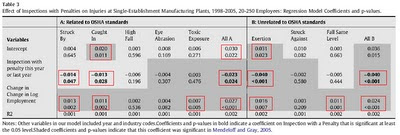勞動檢查能夠預防什麼樣的職業傷害?
What kinds of injuries do OSHA inspections prevent?
Amelia Haviland, Rachel Burns , Wayne Gray , Teague Ruder , John Mendeloff
Journal of Safety Research 41 (2010) 339–345
不要錢的版本(working paper)在這裡
以下用正式發表的版本(有需要的可留言與留下收件email,這篇文章要買的話竟然要USD$31.5)
Abstract:
Objective:
OSHA's enforcement program is one of the major public efforts to protect American workers. We examine both the scope of injury prevention that inspections can contribute and the types of standards that contribute the most. 想了解稽查和各項安全法規規定對於預防工傷的效果
Methods:
We linked Pennsylvania Department of Labor and Industry files for lost-time injuries and employment to calculate injury rates for 1998-2005 for all single-establishment manufacturing firms. We linked these to OSHA inspection records.
Results:
Inspections with penalties did affect injury types unrelated to standards as well as those related. We also found again that citations for violations of the standard requiring personal protective equipment had the largest impact on preventing injuries.
稽查的確可以影響工傷的種類,不論該類工傷是有有相關安全標準規範
而在預防工作傷害方面,PPE有最大的功效
Impact on Industry:
Programs requiring protective equipment use deserve added attention from consultants and inspectors. In addition, some inspections spur managers to undertake safety measures that go beyond compliance with standards.
需要使各個人防護具的作業值得主管多投入一些關注,而官方的稽察可以驅使事業單位執行相關安全措施
OHSA的稽查與開罰對於勞工的傷害類型有影響,而OHSA的相關規定則無關(顯示:法規定的嚴苛沒有意義,真的有執行才有用)
另外各型個人防護具的落實使用對於預防傷害最直接的關連性
摘要看起來四平八穩、但也沒有什麼新意
1. Introduction
Some studies had done by examining whether industries where OSHA inspects more frequently and levies more penalties show improvements in injury and illness rates relative to industries that get less attention (Bartel & Thomas, 1985; Viscusi, 1979, 1986).
Others have linked establishment-level data, from the Bureau of Labor Statistics Survey of Occupational Injuries and Illnesses (SOII) or state workers compensation records, with OSHA inspection records to see whether rates go down when individual workplaces get inspected, penalized, or receive a consultation (Baggs, Silverstein, & Foley, 2003; Gray & Mendeloff, 2005; Gray & Scholz, 1993; Weil, 1996).
Based primarily on evidence from these establishment-level studies (most of them limited to the manufacturing sector), inspections with penalties have been shown to reduce the lost workday injury rate; however, the impact declined steadily from the early 1980s through the 1990s and largely disappeared at workplaces with over 250 employees.
各行業職傷率時間縱斷面研究的罩門:
1. 隨著時間本來就是呈現下降的趨勢:如何分離與判斷各項intervention 的功效?
2. 不同規模公司economic of scale 的干擾
Unlike these others, this paper investigates the process through which OSHA inspections lead to the prevention of injuries. It does so by asking two questions:
• What types of injury events do inspections prevent?
• What particular violations of standards, when cited and abated, are associated with reductions in particular types of injuries and illnesses?
目的:
to understand the scope and limits of OSHA enforcement as an injury prevention program.
to understand more precisely how effective the enforcement of particular standards is. The answers could lead to more emphasis on the enforcement of effective standards and more efforts to understand how to prevent injuries that current standards, as presently enforced, don't seem to address.
先前最接近的研究(即為本文作者之二):
(Mendeloff & Gray, 2005) has examined these questions. It used a data set created by merging the SOII establishment-level data with OSHA inspection records from 1992 through 1998. One major finding was that OSHA inspections with penalties were associated with reductions in injury rates for injuries that were not associated with OSHA standards as well as those that were. The second major finding was that, when OSHA cited firms specifically for violations of personal protective equipment standards, injury rates declined over a range of different injury types.
使用PPE可以減少injury rate,而OHSA inspection可以迫使事業單位落實使用PPE
2. Data and Methods
The data used here came from three different sources: 763,429 injury records from the Pennsylvania Workers Compensation system (WC), 12.8 million quarterly employment records from the Pennsylvania Unemployment Insurance system (UI), and 21,998 inspection records from federal Occupational Safety and Health Administration data (OSHA). These datasets were linked together at the facility level.
This matching process was successful, linking 654,057 (85.7%) of the WC records and 16,740 (76.1%) of the OSHA records to unique UI facilities. We considered only single-facility firms, due to complications in identifying specific facilities in the WC data for a multi-facility firm, which eliminates about 20% of the UI facilities. We also limited the data to manufacturing facilities, since they tend to have more stable (and better-defined) locations, reducing the sample from 473,683 facilities to 22,186 single-facility manufacturing firms operating in Pennsylvania
用是否有相關安全標準規定來分類看待各類傷害,另外比較奇怪的是=>為何各年度各類傷害的比例合計不是100%?是因為扣掉交通還是職業病病假?
方法是:多元回歸,看各解釋變數間的係數存在顯著性
The basic model takes the following form:
解釋變數:不同事故類型的傷害在此一時間內增減率(這部份有做相關數值的轉換),要看附錄B
Appendix B. Modeling the Dependent Variable
至於這樣轉換的理由,作者的意圖在於增加解釋力(但是否合理也或許要在回朔上一篇文章或請教老師了;而此一研究不愧是有統計 博士參與在其中,為達目的不擇手段折磨刑求資料的技巧超凶狠)

等於是只看各年度各類工傷變化率的變化差異?(意圖將本來隨著各年度下降的基本趨勢干擾先消除?!)算是這個研究的方法菁華與核心
Results結果精華在表三
由於有做過相關轉換,所以表三當中只看的到:截距項、近期(this year and next year)是否有受到相關稽查以及員工人數改變的影響
以下這張圖把相關係數存在顯著的部份Mark 出來
而個人看table 3覺得:事業單位人數的增減對於各類工傷,比有沒有稽查來的更具相關性與解釋力
另外R-Square如果真的是0.001的話也很難看(還是指R-Square的顯著性亦或單獨Inspection的R-Square?)
Overall, these coefficients translate to back transformed results of a 4.1% (95% confidence interval 0.6 to 7.6%) annual reduction in the pooled injury rate of those injury causes that are more closely related to OSHA standards and a 7.2% (95% confidence interval 3.2 to 11.1%) annual reduction in the pooled injury rate of those injury causes that are less closely related to OSHA standards. Over the two year period, these amount to a cumulative 8.2% and 14.4% decrease for injury types that we labeled as more or less related to OSHA standards, respectively.
有工作安全規定部分的傷害,稽查大約減小了4.1%(經過轉換的工作傷害數值)
沒有工作安全規定部分的傷害,稽查大約減小了7.2%(經過轉換的工作傷害數值)
表四列出了OHSA稽查的各類缺失件數

不知道為什麼,看到這張表讓我覺得OHSA稽察員也沒高明到哪裡,也或許是這樣的分類方式呈現不出稽核人員的功力與貢獻吧
在用上述的分類對各類區失進行多元回歸(沒有把「change in change in log employment」這個變數放進來回歸,不知道這一放會不會讓結果更難看)
結果如表5
結果變數存在性顯著的大概只有PPE&滅火器對於眼睛刺激類的工傷
In conclusion, the 20% decrease in injuries related to OSHA standards over the two years that followed the citation of PPE standards should encourage OSHA, as well as private safety managers, to give a high priority to understanding the reasons for noncompliance with this standard and for ensuring that it is enforced.
Further research to analyze the impacts of citing other workplace standards may provide further guidance about which are most important for injury prevention.
感想:
從失誤樹的角度來看,工傷的發生可能中間有好幾層的「and」與「or」的因果關聯,難以直接衡量這些中間因素與因果關聯,所以只用這些間接的因素來衡量與各類工傷的關連性
結果自然好看不到哪裡。
這是個顛倒過來的研究,先看實際的數據與現象,再從這些現象當中歸納出:PPE與OHSA的稽查可以減少特定類型的工傷
一般的研究是從理論出發:例如Heinrich的骨牌理論,演繹出減少不安全的行為可以降低工傷,所以觀察不安全行為較少的公司是否有較少的工傷
這篇文章沒有犯用橫斷面資料來推論因果關係的錯誤
另外就多元回歸的統計檢定上,不知道是否存在調節變數項(組織的安全文化)與中介變數項(組織的規模:越大越容易受到稽查)?
這是個顛倒過來的研究,先看實際的數據與現象,再從這些現象當中歸納出:PPE與OHSA的稽查可以減少特定類型的工傷
一般的研究是從理論出發:例如Heinrich的骨牌理論,演繹出減少不安全的行為可以降低工傷,所以觀察不安全行為較少的公司是否有較少的工傷
這篇文章沒有犯用橫斷面資料來推論因果關係的錯誤
另外就多元回歸的統計檢定上,不知道是否存在調節變數項(組織的安全文化)與中介變數項(組織的規模:越大越容易受到稽查)?
(迷之音:以上感想被這五位作者知道的話,應該會被蓋布袋吧!人家A.H.是卡內基美隆的統計學 博士、RB是密西根大學公衛碩士、WG是哈佛經濟學博士、TR是賓州州立大學的經濟學碩士、JM是加州大學柏克萊分校的公共政策博士…..)




沒有留言:
張貼留言